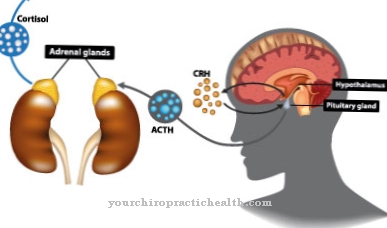Obesity, in German obesity or Obesity, particularly often affects people in industrialized countries and the western world. In Germany, over 20 percent of people are considered obese.
What is Obesity?

Obesity is derived from the Latin word "adeps" for fat. According to experts, this increase in body fat is classified as a chronic disease. Not every overweight person is equally obese.
According to the World Health Organization, obesity is present from a BMI (body fat index) of 30. A total of 3 degrees of severity are distinguished, which are also subject to the BMI in their classification.
A grade I obesity has a BMI of 30-35, up to a BMI of 40 people are affected by a grade II obesity, above this is only grade III, which is also called morbid obesity. The quality of life is already significantly reduced here, life expectancy is significantly lower than that of people of normal weight.
causes
Obesity occurs more and more in western industrialized countries, which suggests that the causes can be derived from living conditions. Studies have shown that there is a direct relationship between the daily intake of fat and obesity, but not the generally excessive intake of calories.
Even sugary drinks lead to overweight and ultimately obesity. In addition to the wrong diet, too little exercise is a cause of obesity. In this context, lack of exercise means not only too little sport, but also the general living conditions. Sedentary activities, passive leisure activities and a good infrastructure can be found particularly in western countries and, together with the wrong diet, quickly lead to weight gain.
External factors are also reasons for being overweight. The excessive range of goods, the popularity of fast food, a lot of advertising and getting used to sugar and fat (sugary teas, soft drinks, fast food) lead to obesity even in children. Metabolic diseases such as hypothyroidism can also be named as a cause. Studies have shown that genetic predispositions can also lead to obesity.
Symptoms, ailments & signs
The most obvious symptom of obesity is the visible overweight of the person affected, which is noticeable in a full and bulky body shape. Obesity is therefore generally easy to diagnose - even if its causes can be very different in nature. Obesity is in all cases acquired over a long period of time and can be treated with lifestyle changes.
One of the symptoms of obesity is a mostly clumsy gait resulting from restricted mobility. Movement is usually directly linked to breathlessness, because the cardiovascular system has to move and maintain a mass for which it was not designed.Due to the difficulty of mobility, there is usually a physical deficit, since those affected are no longer able to pursue sporting activities.
In the long term, problems arise in the musculoskeletal system caused by excessive loads on the joints and tendons. Back problems such as herniated discs are also more common in obese patients. Last but not least, obesity is one of the main triggers of secondary diseases of the cardiovascular system.
Mostly due to an unhealthy, high-fat diet and too little exercise, blood values also deteriorate. Outwardly unnoticed, deposits form in veins and arteries, which can lead to diseases of the blood vessels and the heart. Strokes and heart attacks are the long-term consequences.
Diagnosis & course
Obesity is primarily determined by the measured BMI. Decisive for the sequelae of obesity, such as high blood pressure or cardiovascular diseases, is not only the BMI, but the distribution of body fat. Fat deposits in the abdomen are rated as poor, as this fat tissue often surrounds the organs and thus has a negative impact on the sugar metabolism.
Belly fat produces bad blood lipids, which raise cholesterol and build up on the walls of the arteries. If the fat is distributed primarily on the thighs or buttocks, we speak of the pear type - this has a lower risk of secondary diseases. The waist circumference and waist-to-hip ratio are also measured for diagnosis. Both provide information about the fat distribution pattern.
Women with a waist circumference of more than 80 cm and men over 92 cm have an increased risk. The waist-to-hip ratio should be below 1 for men, women with a value above 0.85 are considered at risk. These values are seldom meaningful for children, which is why age in relation to height and weight has to be included. This is done with percentile tables.
Differential diagnosis
Diet-related obesity must be clearly distinguished from diseases such as Cushing's syndrome (hypercortisolism), hypothyroidism, lipid metabolism disorders and polycystic ovarian syndrome (polycystic ovary syndrome).
Complications
Obesity can lead to the development of diabetes mellitus (type 2). Diabetes leads to a disorder of the metabolism, the characteristic feature being resistance to the hormone insulin. If left untreated, severe diabetes can lead to death. In addition, other secondary diseases and side effects such as neuropathy are possible.
Often, obesity also gives rise to complications that affect the cardiovascular system. This results in a higher risk of such diseases, which also include heart attacks and strokes. In addition, obesity increases the risk of various cancers.
Metabolic syndrome is a combination of abdominal obesity, insulin resistance, high blood pressure, and dyslipoproteinemia. The latter describes a disturbance in the protein concentrations in the blood serum. The high density lipoprotein (HDL) and the low density lipoprotein (LDL) occur in different proportions.
Obesity is often associated with high cholesterol levels. This promotes arteriosclerosis and gallstones. The excessive weight also leads to increased stress on the musculoskeletal system. The joints and intervertebral discs in particular suffer from obesity. Snoring or temporary suspension of breathing can also occur as complications during sleep.
This sleep apnea syndrome can in turn lead to disturbed sleep behavior: As a result, those affected wake up more often from the deep sleep phases, which are important for the normal regeneration of the body.
When should you go to the doctor?
Many people suffer from increased weight. Most people affected by obesity will probably not see a doctor unless they are suffering from serious sequelae. The reason: Despite all the media information, there is often a lack of insight into the long-term health effects that being overweight can have.
Many overweight people no longer dare to see a doctor. An increasing sense of shame ensures that the body weight increases even further. Sooner or later, possible consequences of obesity will occur. Even if there are no pathological symptoms as a result of being overweight, a doctor should be consulted. As a minimum, an annual health check-up and all the preventive examinations provided for the age group are advisable.
If vegetative disorders such as excessive sweating, shortness of breath or increasing shortness of breath or palpitations occur with little exertion, a doctor's visit is necessary. The symptoms can be reduced by dieting. If there are musculoskeletal symptoms, pain and constant muscle tension, a doctor's visit is necessary. Otherwise there is a risk of permanent damage. Obesity can lead to chronic diseases with a progressive course of the disease. Regular visits to the doctor can prevent this.
Visits to the doctor are also advisable if the person concerned notices that he is missing out on social and professional opportunities and is being sidelined due to his weight problem. If the massive overweight is due to emotional problems, a psychotherapist should be consulted.
Doctors & therapists in your area
Treatment & Therapy

The primary goal of therapy is always weight loss. This often requires serious interventions in living conditions. Diet is the main cause of obesity in the majority of obese patients. Education about healthy eating is the first step in treating obesity.
Since wrong behavior and eating patterns develop over years, behavior therapy is often advisable. An attacked self-image and psychological causes must also often be treated, which is why psychotherapy is often indicated. The second important pillar in the fight against obesity is exercise. The WHO recommends 30-60 minutes of exercise at least 3 times a week for weight loss. A detailed consultation is also necessary here so that the joints and tendons of the obese person are not damaged.
With children, families and relatives need to be closely involved in the therapy process. Surgical measures are also available for severe obesity from grade II with other diseases such as diabetes or heart disease. A gastric band or stomach reduction are restrictive procedures and prevent people from eating. Combined operations can also affect the gastrointestinal tract and not only directly influence food intake, but also lipid metabolism.
Medicines such as appetite suppressants are not suitable for obesity therapy. The only approved agent is orlistat, which interferes with lipid metabolism and disrupts the absorption of dietary fats. However, this drug should only be used in conjunction with therapy, as primarily eating habits and lack of exercise must be treated by changing behavior.
Outlook & forecast

People who are severely overweight are at risk of developing metabolic syndrome. Likewise, the probability of heart attacks, heart failure and high blood pressure is greatly increased.
As a rule, obesity is a relatively dangerous and also very unhealthy condition for the patient's body. If this is not treated or the weight is not drastically reduced, life-threatening symptoms and, in the worst case, death can result.
In most cases, patients have restricted mobility and are quickly exhausted when the body is strained. The increased sweating often leads to an unpleasant body odor and the increased weight leads to pain in the joints. Furthermore, there are also heart problems, so that most patients are exposed to cardiovascular diseases and possibly suffer a heart attack.
The patient's stout figure sometimes leads to psychological complaints and social exclusion. Children in particular can suffer from bullying and teasing due to obesity and develop severe psychological complaints as a result. Furthermore, diabetes can develop.
Obesity can be treated, although the patient himself is responsible for proper treatment. Only medical treatment is possible in a few cases. The disease can be counteracted through a healthy lifestyle and sporting activities. Psychological treatment may also be necessary to combat the causes of obesity.
prevention
A healthy lifestyle from childhood is the best prevention against obesity. The diet should contain as little fat and sugar as possible, and exercise should be on the program 2 to 3 times a week. Children in particular are very receptive to preventive measures and healthy eating habits and a lot of exercise become normal, which continue into adulthood.
Aftercare

Follow-up care after an operation for an obesity disease is lifelong. There are six appointments in the first year, two in the second and an annual one thereafter. If the patient has complaints, regardless of the appointment, he should contact the attending physician. The challenge for those affected is to change their way of life, which primarily affects diet and exercise behavior.
Here they mostly need support so as not to fall back into old patterns. It can take the form of nutritional advice, a doctor or a self-help group. A nutrition plan is an essential part of the first few weeks. In addition, side effects of obesity such as diabetes and high blood pressure will most likely decrease.
The drug treatment must therefore be adapted. If the intestine can obtain fewer nutrients from food as a result of the surgery, dietary supplements must be prescribed. The dose of these must be adjusted annually, depending on the patient's health.
Since obese patients often have decreased self-esteem, it is important that social inclusion is part of the follow-up to prevent relapse. This can be done by entering professional life soon or by finding new hobbies. If necessary, behavior therapy can be prescribed to help the patient with the challenges of everyday life.
You can do that yourself
People who are overweight can do a lot to help lose weight. When it comes to obesity, awareness of the disease and the will to change are essential when it comes to weight loss. Anyone who does not want to admit to being massive overweight and does not see any point in a significant change in eating and exercise habits will lose weight sustainably and healthily through practically no medical treatment.
If necessary, psychological counseling and therapy are an important component that can be approached in parallel to a medically supported diet. Obesity can only be successfully countered as part of a diet if you eat less than you consume every day. So the negative calorie balance is the goal.
As long as there are no specific health concerns, every person can do something to lose weight in everyday life with a fat and calorie-reduced diet while increasing calorie consumption through exercise. It is important to know that weight loss in everyday life should be brought about slowly and not through crash dieting. These cause a significant reduction in the basal metabolic rate and thus significantly increase the yo-yo effect.
In-depth knowledge of nutrition is therefore advisable if you want to do something against obesity yourself. You can acquire this yourself, but also with the help of courses, for example those offered by health insurance companies. Self-help groups can also be of great help in everyday weight loss.





.jpg)





















